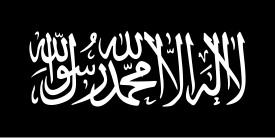
Back حركة أوزبكستان الإسلامية Arabic Özbəkistan İslam Hərəkatı Azerbaijani ইসলামিক মুভমেন্ট অফ উজবেকিস্তান Bengali/Bangla Moviment Islàmic de l'Uzbekistan Catalan Islamische Bewegung Usbekistan German Movimiento Islámico de Uzbekistán Spanish Usbekistani Islamiliikumine Estonian جنبش اسلامی ازبکستان Persian Uzbekistanin islamilainen liike Finnish Mouvement islamique d'Ouzbékistan French
| Islamic Movement of Uzbekistan (IMU) | |
|---|---|
  | |
| Founders | Tohir Yoʻldosh † Juma Namangani † |
| Leaders | Tohir Yoʻldosh † Juma Namangani † Abu Usman Adil[2] † Usman Ghazi[3] † Samatov Mamasoli (aka Abu Ali) |
| Dates of operation | August 1998[4]–2015[5]
2016[6]–present |
| Allegiance | |
| Motives | Enforcement of Sharia in Uzbekistan and eventually a Central Asian Caliphate[8] |
| Headquarters | Afghanistan[9] |
| Active regions | Federally Administered Tribal Areas of Pakistan Northern Afghanistan[10] Xinjiang region in China[11] |
| Ideology | Current: Islamism Pan-Islamism Salafi Jihadism Anti-Zionism Historical: Anti-Islam Karimov |
| Size | 200–300 (after 2015)[12] ~3,000 (2013)[13] 500–1,000 (2004)[14] Unclear (post 2016), reportedly 700 plus family members. |
| Allies |
|
| Opponents | |
| Battles and wars | Batken conflict Afghan Civil War (1996–2001) War in Afghanistan (2001–2021) Insurgency in Khyber Pakhtunkhwa |
| Organization(s) | Islamic Movement of Turkestan (The government of Tajikistan claims to be an alias) |
| Designated as a terrorist group by | See Section |
The Islamic Movement of Uzbekistan (IMU; Uzbek: Ўзбекистон исломий ҳаракати, Oʻzbekiston islomiy harakati; Russian: Исламское движение Узбекистана) was a militant Islamist group formed in 1998[4][19] by Islamic ideologue Tahir Yuldashev and former Soviet paratrooper Juma Namangani; both ethnic Uzbeks from the Fergana Valley. Its original objective was to overthrow President Islam Karimov of Uzbekistan and create an Islamic state under Sharia; however, in subsequent years, it reinvented itself as an ally of Al-Qaeda. The group also maintained relations with Afghan Taliban in 1990s.[9] However, later on, relations between the Afghan Taliban and the IMU started declining.[4]
Operating out of bases in Tajikistan and Taliban-controlled areas of northern Afghanistan, the IMU launched a series of raids into southern Kyrgyzstan in the years 1999 and 2000. The IMU suffered heavy casualties in 2001–2002 during the American-led invasion of Afghanistan. Namangani was killed, while Yuldeshev and many of the IMU's remaining fighters escaped with remnants of the Taliban to Waziristan, in the Federally Administered Tribal Areas of Pakistan. The IMU then focused on fighting the Pakistan Forces in the Tribal Areas, and NATO and Afghan forces in northern Afghanistan.[20][21]
In mid-2015, its leadership publicly pledged allegiance to the Islamic State of Iraq and the Levant (ISIL) and announced that the IMU was part of the group's regional branch.[22][23] In 2016, it was reported that a new faction of Islamic Movement of Uzbekistan emerged after the group became part of ISIL. The new faction retained the group's name and was independent of ISIL. It has also indicated that it is loyal to al-Qaeda and the Taliban and shared their views against ISIL.[6]
- ^ "The Islamic Movement of Uzbekistan's Enduring Influence on IS-Khurasan". Global Network on Extremism & Technology. 3 March 2023. Retrieved 3 March 2023.
- ^ "Islamic Movement of Uzbekistan names Abu Usman as new leader". The Long War Journal. 17 August 2010.
- ^ Cite error: The named reference
ReferenceAwas invoked but never defined (see the help page). - ^ a b c d e "Islamic Movement of Uzbekistan". Center for International Security and Cooperation (CISAC). Retrieved 10 September 2019.
- ^ "The IMU is extinct: what next for Central Asia's jihadis?". cacianalyst.org.
- ^ a b "Islamic Movement of Uzbekistan faction emerges after group's collapse". Long War Journal. 2016-06-14. Retrieved 2016-06-15.
- ^ "Many Jihadi Groups In Asia & Africa Pledge Allegiance To Taliban Leader, Group Sources". 9 October 2024.
- ^ "Tajikistan and Afghanistan". Institute for the Study of War. Retrieved 2014-10-09.
While the IMU still seeks to topple the Uzbek government, it now also wants to establish an Islamic Caliphate that spans Central Asia.
- ^ a b c "Uzbekistan Experiences The Pitfalls Of Peacemaking In Afghanistan". Radio Free Europe/Radio Liberty. 24 August 2019.
- ^ Cite error: The named reference
rferlwas invoked but never defined (see the help page). - ^ "The Diplomat". 17 August 2016. Retrieved 30 November 2016.
- ^ "Country Reports on Terrorism 2017 - Foreign Terrorist Organizations: Islamic Movement of Uzbekistan". UNHCR. United States Department of State. Retrieved 19 September 2018.
- ^ "The radical Islamic militants of central Asia" (PDF).
- ^ "Terrorist Organization Reference Guide" (PDF). 13 December 2006. Archived from the original (PDF) on 13 December 2006.
- ^ "Beijing, Kunming, Urumqi and Guangzhou: The Changing Landscape of Anti-Chinese Jihadists". Jamestown. Jamestown Foundation. 23 May 2014.
- ^ "QE.I.10.01. ISLAMIC MOVEMENT OF UZBEKISTAN". United Nations. 7 April 2011. Archived from the original on June 9, 2013. Retrieved 10 October 2014.
- ^ "Three groups active in Xinjiang banned". Dawn News. 23 October 2013. Retrieved 30 November 2016.
- ^ Bruce Pannier. "Northern Afghanistan and the New Threat to Central Asia - Foreign Policy Research Institute". www.fpri.org. Retrieved 2023-04-24.
- ^ Rashid, Ahmed (2001). "The Fires of Faith in Central Asia". World Policy Journal. 18 (1): 45–55. doi:10.1215/07402775-2001-2001. JSTOR 40209731.
- ^ Sidikov, Alisher (July 2, 2003). "Pakistan Blames IMU Militants For Afghan Border Unrest". Radio Free Europe/Radio Liberty. Retrieved 2008-07-03.
- ^ "Country Reports on Terrorism 2011". United States Department of State. 31 July 2012. Retrieved 2014-10-10.
- ^ "IMU Declares It Is Now Part Of The Islamic State". Radio Free Europe/Radio Liberty. 6 August 2015. Retrieved 6 August 2015.
- ^ Cite error: The named reference
IMU joins ISILwas invoked but never defined (see the help page).